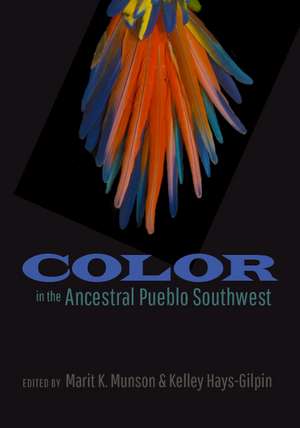Color in the Ancestral Pueblo Southwest
Editat de Marit K. Munson, Kelley Hays-Gilpinen Limba Engleză Hardback – 26 mar 2020
Color attracts attention, evokes emotions, conveys information, carries complex meanings, and makes things beautiful. Color is so meaningful, in fact, that research on the color choices of Ancestral Pueblo people has the potential to deepen our understanding of religious, social, and economic change in the ancient Southwest. This volume explores museum collections and more than a century of archaeological research to create the first systematic understanding of the many ways Ancestral Pueblo people chose specific colors through time and space to add meaning and visual appeal to their lives.
Beginning with the technical and practical concerns of acquiring pigments and using them to create paints, the authors explore how connections to landscapes and sacred places are embodied by many colorful materials. Contributors examine the development of polychromes and their juxtaposition with black-on-white vessels; document how color was used in rock paintings and architecture; and consider the inherent properties of materials, arguing that shell, minerals, and stone were valued not only for color but for other visual properties as well. The book concludes by considering the technological, economic, social, and ideological factors at play and demonstrates the significant role color played in aesthetic choices.
Beginning with the technical and practical concerns of acquiring pigments and using them to create paints, the authors explore how connections to landscapes and sacred places are embodied by many colorful materials. Contributors examine the development of polychromes and their juxtaposition with black-on-white vessels; document how color was used in rock paintings and architecture; and consider the inherent properties of materials, arguing that shell, minerals, and stone were valued not only for color but for other visual properties as well. The book concludes by considering the technological, economic, social, and ideological factors at play and demonstrates the significant role color played in aesthetic choices.
Preț: 394.57 lei
Nou
Puncte Express: 592
Preț estimativ în valută:
75.50€ • 79.05$ • 62.62£
75.50€ • 79.05$ • 62.62£
Carte disponibilă
Livrare economică 19 martie-02 aprilie
Preluare comenzi: 021 569.72.76
Specificații
ISBN-13: 9781607817208
ISBN-10: 1607817209
Pagini: 192
Ilustrații: 72 illustrations, 1 map, and 4 tables
Dimensiuni: 178 x 254 x 15 mm
Greutate: 0.57 kg
Editura: University of Utah Press
Colecția University of Utah Press
ISBN-10: 1607817209
Pagini: 192
Ilustrații: 72 illustrations, 1 map, and 4 tables
Dimensiuni: 178 x 254 x 15 mm
Greutate: 0.57 kg
Editura: University of Utah Press
Colecția University of Utah Press
Recenzii
“Archaeologists are often hesitant to go out on a limb to pursue certain lines of evidence. It takes guts to think outside the box, draw together multiple gossamers of evidence, and weave them into a convincing fabric. The volume in question could not have had better editors and authors for such a task. The discussions of colors’ multidimensionality, embodiment, animation, and nexus with history are fascinating, and I suspect that readers will adopt similar approaches with their own research.”
—Will G. Russell, historic preservation specialist, Arizona Department of Transportation
—Will G. Russell, historic preservation specialist, Arizona Department of Transportation
“This is a beautiful book, filled with stunning color illustrations and illuminating ideas that will open eyes and minds for archaeologists of all stripes…. Professionals will find [the book] thorough and well referenced. At the same time, it should also appeal to the educated, interested public because of its subject matter and because it is so clearly written and presented.”
—American Antiquity
“This volume will encourage archaeologists to look at the importance of color in many aspects of research that have been heretofore ignored. It should lead to a better understanding of Ancestral Puebloan people in many aspects of their lives.”
—American Archaeology
Notă biografică
Marit K. Munson is an anthropological archaeologist at Trent University in Ontario, Canada. She is author of The Archaeology of Art in the American Southwest and coeditor (with Susan Jamieson) of the awarding-winning book Before Ontario: The Archaeology of a Province.
Kelley Hays-Gilpin is professor of anthropology at Northern Arizona University and Edward Bridge Danson Curator of Anthropology at the Museum of Northern Arizona. Her books include Painting the Cosmos: Metaphor and Worldview in Images from the Southwest Pueblos and Mexico (with Polly Schaafsma) and Belief in the Past: Theoretical Approaches to the Archaeology of Religion (with D.S. Whitley).
Kelley Hays-Gilpin is professor of anthropology at Northern Arizona University and Edward Bridge Danson Curator of Anthropology at the Museum of Northern Arizona. Her books include Painting the Cosmos: Metaphor and Worldview in Images from the Southwest Pueblos and Mexico (with Polly Schaafsma) and Belief in the Past: Theoretical Approaches to the Archaeology of Religion (with D.S. Whitley).
